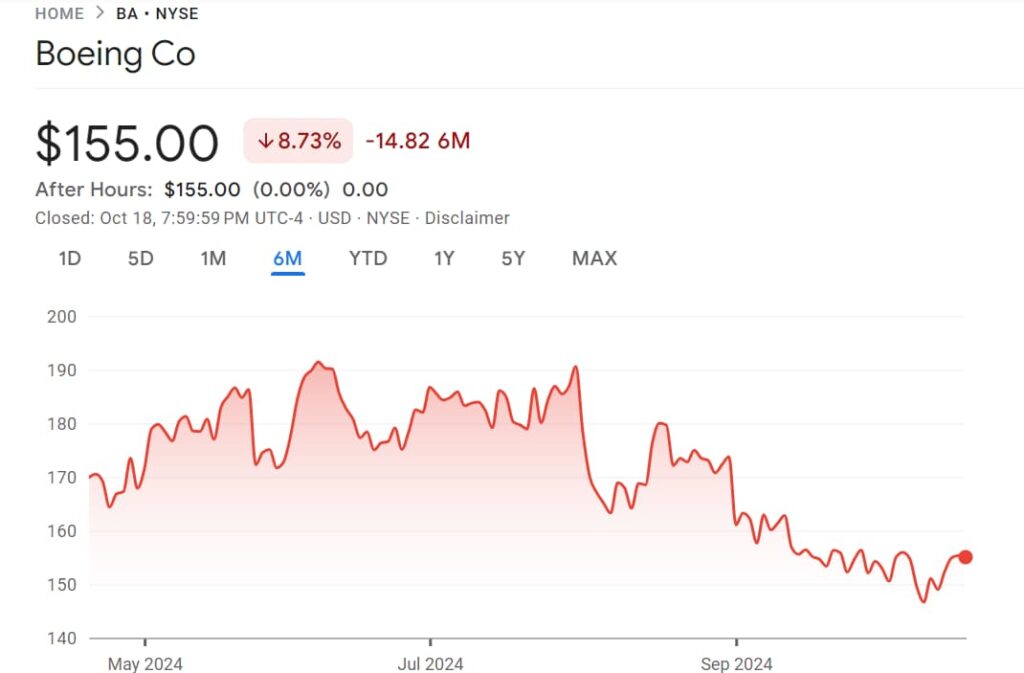Boeing Co. (NYSE: BA) is currently navigating one of the most challenging periods in its history, with its stock down approximately 40% year-to-date, making it one of the worst performers on the Dow Jones Industrial Average.
While the aerospace giant has faced turbulence before, the confluence of operational setbacks, financial strain, regulatory scrutiny, and labor disputes suggests that this downward trend may continue for some time.

At press time, BA stock is trading at $155, with a 1.2% decrease over the last thirty days.
Operational setbacks amplify financial strain
The company’s second-quarter earnings report for 2024 painted a grim picture. Boeing reported a net loss of $1.44 billion, or $2.33 per share, compared with a loss of $149 million, during the same period last year.
On an adjusted basis, the company posted a loss of $2.90 per share, missing analyst expectations by nearly $1 per share.
Boeing’s share price has faced a sharp decline since September 2023, following the company’s warning of potential production delays for its 737 MAX jets due to quality control issues, leading to the grounding of several planes.
The start of 2024 brought additional challenges for Boeing, including incidents such as a mid-flight decompression on an Alaska Airlines flight, an emergency landing due to an engine fire on a 747-8, and a cracked cockpit window on a 737 MAX 9 during Japan’s All Nippon Airways (ANA) flight, further compounding the company’s troubles.
Labor disputes with no end in sight
A significant contributor to these setbacks is the ongoing strike by 33,000 machinist workers from the International Association of Machinists (IAM), which has now entered its sixth week.
The labor dispute centers on the union’s demand for a 40% wage increase, while Boeing has only offered a 30% raise. However, Boeing has withdrawn its offer as negotiations with union representatives reached a stalemate.
This dispute has effectively halted production lines for some of Boeing’s most profitable aircraft models, including the 737 MAX, 767, and 777. The strike is estimated to be costing Boeing over $1 billion per month, exacerbating its already precarious financial situation.
The prolonged strike not only affects Boeing but also has a ripple effect across its supply chain.
For instance, suppliers like Spirit AeroSystems have begun furloughing 700 workers for 21 days due to the production stoppage, which could lead to further supply chain disruptions even after the strike ends.
Regulatory and safety scrutiny intensifies
In addition to financial and labor pressures, Boeing is facing increasing regulatory scrutiny.
The Federal Aviation Administration (FAA) has launched a new three-month review of Boeing’s safety compliance, following an incident in January when a door panel blew off a 737 MAX mid-flight, causing cabin depressurization.
This, along with other minor safety issues, has raised fresh concerns about Boeing’s manufacturing processes and safety culture.
Furthermore, the National Transportation Safety Board (NTSB) recently issued an urgent recommendation regarding rudder issues affecting certain Boeing 737 models, prompting the FAA to issue a safety alert to airlines.
These growing safety concerns have kept Boeing under the regulatory microscope, further limiting the company’s ability to ramp up production and meet the rising demand for aircraft.
Additionally, a whistleblower’s statement to the Senate earlier this year alleged that Boeing was aware of several safety issues but chose to downplay them in a rush to meet production targets.
This has only deepened the distrust in Boeing’s safety culture and its ability to produce reliable aircraft.
Cash flow crisis and analyst outlook
Boeing’s financial troubles extend beyond missed earnings and production stoppages. The company is also facing a cash flow crisis due to the ongoing strike and regulatory challenges.
In an effort to address this, Boeing recently announced a 10% reduction in its white-collar workforce, amounting to 17,000 jobs. Additionally, the company revealed plans to raise up to $25 billion through a mixed offering of debt and stock while also securing a $10 billion credit line.
“Over the coming months, we are planning to reduce the size of our total workforce by roughly 10 percent. These reductions will include executives, managers and employees.”
-CEO Kelly Ortberg
Despite these headwinds, some analysts maintain a cautiously optimistic outlook on Boeing’s future. The consensus rating among 24 analysts is a “Moderate Buy,” with a mean target price of $206.33, suggesting a potential upside of 35.4%.
However, other analysts are more bearish. Bernstein analyst Douglas Harned lowered the firm’s price target on Boeing to $195 from $207, citing the deepening challenges across Boeing’s business units and the likelihood of further cash flow pressures.
Similarly, Susquehanna reduced its price target to $210 from $230, raising concerns over the prolonged strike’s impact on deliveries, production, and cash flow.
Why Boeing’s descent may not be over
While Boeing has taken steps to address its immediate financial and operational issues, investors should remain cautious.
Boeing’s path to recovery is riddled with uncertainty. The combination of financial strain, production halts, and regulatory challenges suggests that Boeing’s descent may be far from over.
Until the company can resolve its labor disputes, restore production, and regain regulatory confidence, the stock is likely to remain under pressure, and any recovery may take longer than optimistic projections suggest.
However, the striking union is reportedly in active ‘indirect discussions‘ with Boeing, aiming to reach a deal that could bring an end to the prolonged standoff.
Investors are now closely watching Boeing’s next quarterly earnings report, scheduled for Wednesday, October 23, 2024.







